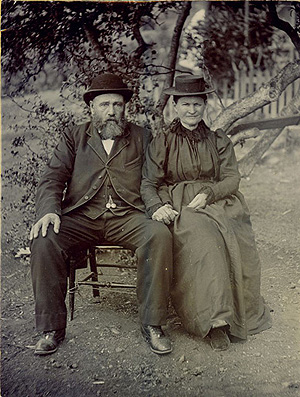The South African War (1899-1902)

Photographer unknown, British?
Pieter Arnoldus Cronjé, and his Wife, Prisoners of South African War, St. Helena Island, British Overseas Territory, about 1902
silver print; 25.4 x 18 cm
Taken at St. Helena and brought to New Brunswick by Dr. Leverett Herbert Price (Havelock, N.B. 1868-Westmorland County, N.B., 1933) who accompanied General Cronje to St. Helena aboard the SS Milwaukee.
Gift of Minerva B. Frost, 1931
On 11 October of 1899 war broke out between the British colonies of Cape and Natal and the Boer Republics, namely the Orange Free State and Transvaal. Soon after the war began, Canadian soldiers were recruited and joined the British cause. The 2nd Special Service (S.S.) Battalion of the Royal Canadian Regiment of Infantry (RCRI) was raised across Canada and each company was designated a letter. Volunteers from New Brunswick and Prince Edward Island made up the ranks of ‘G’ Company. The majority of men who enlisted for New Brunswick were from Saint John and the surrounding areas. The ninety available positions were quickly filled and the men were sent off to South Africa, traveling on the steamer Sardinian. The 2nd (S.S.) Battalion of the RCRI arrived in Cape Town, South Africa, on 29 November 1899.
This was the first war in which Canadians fought outside of North America. Canadian men had served overseas in the past but always within the British army. Thus the Boer War marked Canada’s first military expedition abroad as a country.
The war itself was long and particularly devastating for both sides. Perhaps one of the most significant battles during the war was the battle of Paardeberg, which took place on 12 February 1900 and ended on the 27th with the surrender of General Pieter Arnoldus Cronje (1836-1911). This battle was one of the largest during the war and represents Canada’s first overseas battle.
By the summer of 1900 it appeared as though the war was nearly over. Most of the members of the 2nd (S.S.) Battalion RCRI took up communication duties and were no longer required to fight. On 2 October of the same year, all those who had not re-enlisted from the Canadian contingent sailed back to Canada from Cape Town on the steam ship Idaho. Many other Canadian units served in the war following their departure. The war continued for another year and a half until a peace was signed between both sides on 31 May 1902 and both of the Boer Republics became British colonies.
